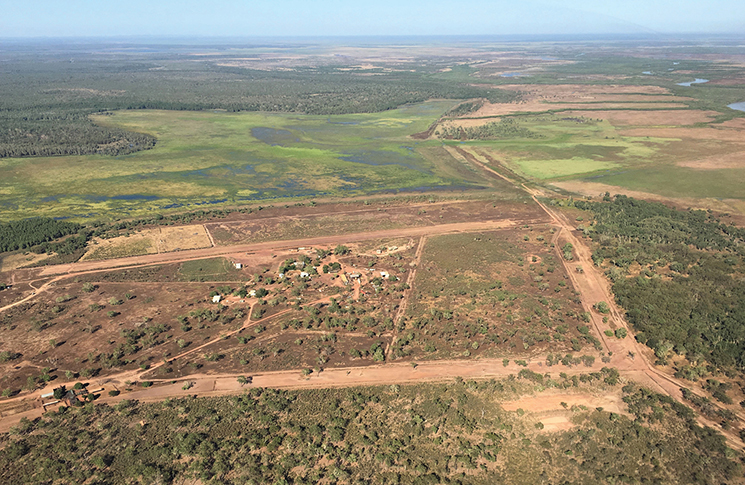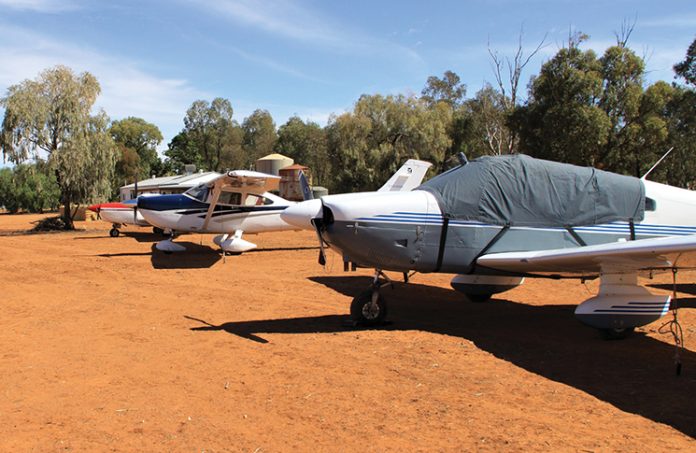Uncertified aerodromes, bush strips and paddocks can be perfectly good landing areas – or traps. It’s up to you to find out which is which for your aircraft and skill level.
Learning to fly typically begins in the comfort of a larger aerodrome, with a wide, long and well-maintained runway – a forgiving environment for fledgling pilots.
Invariably, familiarity and comfort give way to the excitement of landing at new locations, with the clear objective of going places requiring the pilot to manage progressively less perfect runways. For some locations, the word ‘runway’ might even be a bit of a stretch, with paddock, field, road or hillside being the better description.
With new locations come new decisions and, sooner or later, most pilots find themselves asking, ‘Can I land there?’
The answer is important but often unclear and inherently subjective. First, getting information on the airstrip you’re interested in flying to can be difficult. Then, even with accurate and complete information, understanding the capabilities of both you and your aircraft can lead to wildly different conclusions. Ultimately, even informed and responsible decisions can result in diversions, delays or damage to an aircraft.
The teacher
I first met Shelley Ross last year in Karumba, Queensland. Shelley was on holidays, flying a Cessna 172 around northern Queensland, while I was at work, taking our company’s Cessna Caravan to the tip of Cape York with 8 excited guests. Shelley was headed to Mt Mulligan Lodge, a luxury station destination about 100 kilometres inland from Cairns.
Only months earlier, the company I work for had been planning to land there but was unable, due to the runway being littered with anthills and in need of grading – a by-product of the impact on tourism of the COVID-19 years. I was delighted to hear from Shelley that this situation had been rectified and the runway at the lodge, although still with its own set of challenges, was now back in relatively good shape.
When not flying for fun, Shelley is an instructor at Bathurst-based WardAir, a flight training organisation that has become well known for the air safaris it organises for student pilots. When I asked her about the titular question, she immediately said, ‘We actually have to do this a fair bit!’ She said the students, although well supported, were ‘not always going to towns – they’re going to stations, private properties, where there is no published information to be had’.
The book
The first real challenge of determining if somewhere is safe to land is information. As I write, the ERSA contains 740 entries; however, more than 3,000 locations in Australia have a four-letter designator code and no doubt numerous locations are used as landing areas without any formal recognition. For locations without a designator or ERSA entry, the starting point for information is often – nothing.
Even within those 740 entries, Shelley identifies a hidden hazard – uncertified ERSA entries or those with a grey shaded background. ‘Unlike certified entries, uncertified ERSA entries can be out of date or inaccurate,’ she says. ‘If it’s uncertified, we remind them it is the pilot’s responsibility to determine whether the airstrip is suitable to use.’ Also lacking on these entries is a NOTAM service to notify pilots of aerodrome hazards or unserviceability.
Where the strip is uncertified or undocumented, the next step is contacting whoever owns the location; you’re looking for the vital information – coordinates, elevation, direction, length, width, surface – along with any of the big need-to-knows about the strip. Shelley says, more often than not, the owner is not a pilot. ‘If this is the case, you’ll need to get a second opinion on all the details they give you.’
They’re going to stations, private properties, where there is no published information to be had.
Apart from the particulars, the next key piece of information Shelley asks her students to find out is who has flown in recently and in what type of aircraft. ‘The owner might just forget to tell you that the only person who ever uses his strip is his neighbour, in his ultralight Drifter.’
Having this information gives you context but may also be a vital contact to give you another pilot’s appreciation on the strip and whether or not you can land there.
Permission and information
Doug Sprigg wears many hats – pilot, business owner, geophysicist, astronomer. He’s also responsible for a unique private airstrip, Arkaroola, nestled in the Flinders Ranges in South Australia. The 650-metre strip is attached to Arkaroola Wilderness Sanctuary, a 610-square kilometre nature reserve, which is home to, among other wildlife, the yellow-footed rock-wallaby. Doug says more than 100 aircraft visit his strip each year, the majority to stay at the wilderness sanctuary.
Arkaroola has an uncertified entry in the ERSA, clearly noting PPR – prior permission required. Doug is quick to explain why he lists Arkaroola as PPR. ‘As far as we’re concerned, the permission requirement is mostly about helping pilots appreciate if they and their aircraft are capable of landing here,’ he says.
Arkaroola is only 800 feet elevation, but in the really hot weather in January, density altitude can be a real trap – sometimes 4,000 feet or higher – which increases your take-off and landing distances.
Arkaroola is a strip with some unique characteristics, with the high terrain of the Flinders Ranges to the north and west. It’s also relatively short at 650 metres and not completely level, information not available in the ERSA but detailed on Arkaroola’s website; this highlights Shelley’s point that uncertified entries in the ERSA need to be verified with the owner. ‘Our strip is level in the northern half but from the half-way point, it slopes down to the south at 1.9%,’ Doug says. ‘We tell people it’s 650 metres, even though it’s actually a little longer, mostly to provide some buffer on that slope.’
Doug has operated his Cessna 207 from Arkaroola for more than 30 years, making him acutely aware of the hazards. The challenge starts with performance. ‘Arkaroola is only 800 feet elevation, but in the really hot weather in January, density altitude can be a real trap – sometimes 4,000 feet or higher – which increases your take-off and landing distances,’ Doug says.
Overlaid on this is the effect of winds in a mountainous area. ‘Any strong westerly or north-westerly winds are dangerous for our strip, as you get windshear and downdrafts, particularly in a go-around.’
Without local knowledge, it can be difficult for pilots to appreciate all of this, even with a briefing, so Doug’s preference is to be on location with a VHF radio when visitors land. ‘We want to know their ETA so we’re there to give them an assessment of the local conditions.’
Although the sanctuary usually charges for transfers to and from the more distant Balcanoona, Doug makes sure to tell visiting pilots beforehand: ‘If you have to go to Balcanoona because of weather, we’ll drop you off or pick you up free of charge.’
He says pilots sometimes land without making a phone call but this is becoming less common. That’s because, with an ERSA entry and a website with extensive details about the strip, PPR is a hard detail to miss for pilots planning to visit.

Resources – who knows?
Doug and Shelley’s comments point to a common strategy in answering the question, ‘Can I land there?’ – engaging others who have first-hand knowledge of the strip you’re going to.
Airstrip guides, ERSA and charts are all important, but when a strip is marginal, they’re probably not going to be the definitive answer you’re looking for. An experienced pilot with knowledge of that strip is the best resource you’ll have in this situation.
Beyond the owner and anyone they might know, Shelley says there is another often overlooked source of first-hand knowledge – local charter operators. ‘Ring them up and have a conversation about what types they’re bringing in and compare it to what you’re looking to use,’ she says. Air transport operators generally have a much narrower risk tolerance than private operations, with more stringent guidance on where they will and won’t land, which can provide good guidance for private operations as well.
Experience is the best teacher and, over time, the pilot’s experiences of comparable strips eventually form a strong decision-making process for using marginal airstrips. On the road to that experience, CASA provides several resources to help pilots make good decisions about where to take their aeroplane.
Advisory Circular 91-02 – ‘Guidelines for aeroplanes with MTOW not exceeding 5,700 kg, suitable places to take off and land’ – which was updated in November 2022, provides a relatively comprehensive overview of legislative requirements for using landing areas, along with practical strategies to be used in assessing those areas.
That’s all the regulations give you when it comes to choosing where to land – a place that is suitable.
Factors that can be applied to landing distances are listed in the circular, which can assist in assessing performance when the airstrip does not match the often-ideal conditions of aircraft performance charts. It also provides guidance on assessing conditions, surfaces and slopes.
CASA’s Pilot safety hub centralises resources on a wide variety of topics. For example, the flight planning section has information highlighting some of the challenges of landing at remote and unprepared airstrips, as well as strategies to minimise the risks associated with them.
The Visual Flight Rules Guide, now at version 7.2, is a comprehensive guide to VFR flight operations. It includes a section called ‘Take-off and landing requirement – use of aerodromes’ that summarises the guidance from AC 91-02.
Responsibility – the breakfast table trap
CASR 91.410 requires that if a place is not a certified aerodrome, then it must be a ‘place that is suitable for the landing and take-off of aircraft’. That’s all the regulations give you when it comes to choosing where to land – a place that is suitable.
Breaching CASR 91.410 is an offence of strict liability, meaning that simply being unaware of something about a landing location that makes it unsuitable, is not a defence. Unfortunately, pilots too often discover that somewhere is unsuitable only after a mishap while landing there. The onus for ensuring that somewhere is suitable to land is entirely on the pilot in command – they are responsible, they own the outcome.
Given the potential for trouble with challenging airstrips, Shelley’s final message for her students is one of caution.
‘So, you’ve done your homework, don’t be led by the Top Guns in your group,’ she says. ‘Make your own decision in the quiet of your room before getting caught up in the bravado of the get-there-it is gang at the breakfast table. Know your personal limitations, keep your eyes open and always keep a go-around firmly in your mind.
Resources
- Read Advisory Circular 91-02.
- The VFRG is available in print and online at our online store.
- Visit the pilot safety hub.






I am the manager of what was once a fire bombing airstrip and is now just slashed once a year for fire season preparedness and not used for aircraft. We are getting occasional requests from pilots to land at this site. A helicopter landing to use it as a refueling site when they are checking powerlines is not an issue. What is the liability as the landowner of a private fixed wing pilot landing on the site and having an accident or incident, whether permission is given or not.